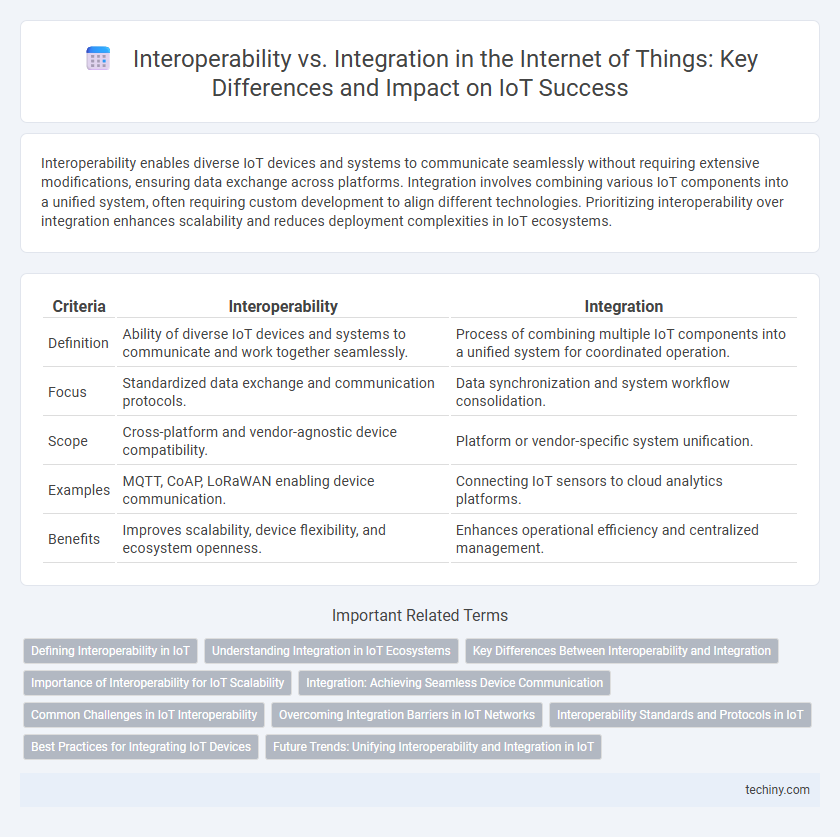Interoperability enables diverse IoT devices and systems to communicate seamlessly without requiring extensive modifications, ensuring data exchange across platforms. Integration involves combining various IoT components into a unified system, often requiring custom development to align different technologies. Prioritizing interoperability over integration enhances scalability and reduces deployment complexities in IoT ecosystems.
Table of Comparison
| Criteria | Interoperability | Integration |
|---|---|---|
| Definition | Ability of diverse IoT devices and systems to communicate and work together seamlessly. | Process of combining multiple IoT components into a unified system for coordinated operation. |
| Focus | Standardized data exchange and communication protocols. | Data synchronization and system workflow consolidation. |
| Scope | Cross-platform and vendor-agnostic device compatibility. | Platform or vendor-specific system unification. |
| Examples | MQTT, CoAP, LoRaWAN enabling device communication. | Connecting IoT sensors to cloud analytics platforms. |
| Benefits | Improves scalability, device flexibility, and ecosystem openness. | Enhances operational efficiency and centralized management. |
Defining Interoperability in IoT
Interoperability in IoT refers to the ability of diverse devices, systems, and applications to communicate, exchange data, and operate seamlessly without human intervention. It involves standard protocols, data formats, and communication frameworks that ensure consistent information sharing across heterogeneous IoT platforms. Defining interoperability emphasizes open standards, compatibility, and scalability to enable efficient integration and collaborative functionality in interconnected IoT ecosystems.
Understanding Integration in IoT Ecosystems
Integration in IoT ecosystems involves seamlessly connecting diverse devices, platforms, and protocols to enable coherent data exchange and unified control. Effective integration ensures real-time communication between sensors, gateways, cloud services, and applications, enhancing system functionality and operational efficiency. Challenges include standardizing data formats, handling heterogeneous technologies, and maintaining scalability as IoT networks expand.
Key Differences Between Interoperability and Integration
Interoperability in the Internet of Things (IoT) refers to the ability of diverse devices and systems to communicate, exchange data, and function cohesively without significant modification, emphasizing standardized protocols and data formats. Integration involves combining different IoT components or systems into a unified solution, often requiring custom development to ensure components work together effectively. Key differences include interoperability's focus on seamless, standardized communication across platforms, while integration is a tailored process to merge specific systems for targeted functionality.
Importance of Interoperability for IoT Scalability
Interoperability enables seamless communication among diverse IoT devices and platforms, which is crucial for scalable network expansion. Unlike integration, which focuses on connecting specific systems, interoperability ensures standardized protocols that allow new devices to join the ecosystem effortlessly. This standardization reduces complexity and operational costs, driving sustainable growth in large-scale IoT deployments.
Integration: Achieving Seamless Device Communication
Integration in the Internet of Things (IoT) enables seamless device communication by unifying diverse systems and protocols into a cohesive network. This process involves consolidating hardware, software, and data streams to ensure synchronized operation across multiple platforms and devices. Achieving integration reduces latency, enhances real-time data exchange, and supports scalable IoT ecosystems for optimized performance and user experience.
Common Challenges in IoT Interoperability
IoT interoperability faces common challenges such as inconsistent communication protocols, diverse data formats, and incompatible hardware platforms that hinder seamless device interaction. Lack of standardized frameworks complicates the integration of heterogeneous IoT systems, leading to fragmented ecosystems and increased development costs. Addressing security, scalability, and data privacy concerns remains critical in achieving effective IoT interoperability across multiple vendors and applications.
Overcoming Integration Barriers in IoT Networks
Overcoming integration barriers in IoT networks requires addressing interoperability challenges between diverse devices, protocols, and platforms. Utilizing standardized communication protocols such as MQTT, CoAP, and OPC UA enables seamless data exchange and system compatibility across heterogeneous IoT ecosystems. Implementing middleware solutions and open APIs further facilitates integration by abstracting device-specific complexities and promoting unified network management.
Interoperability Standards and Protocols in IoT
Interoperability in Internet of Things (IoT) relies on standardized protocols such as MQTT, CoAP, and OPC UA to enable seamless communication between heterogeneous devices and platforms. These interoperability standards facilitate data exchange, device management, and security compliance, reducing vendor lock-in and enhancing system scalability. Effective adoption of open protocols and frameworks accelerates IoT deployment by ensuring cross-vendor compatibility and fostering ecosystem collaboration.
Best Practices for Integrating IoT Devices
Ensuring seamless interoperability and integration of IoT devices requires adopting standardized communication protocols such as MQTT, CoAP, and OPC UA to facilitate consistent data exchange across heterogeneous systems. Implementing centralized IoT platforms helps manage diverse devices, enabling real-time monitoring, data analytics, and automated workflows that enhance operational efficiency. Prioritizing security frameworks like TLS encryption and robust authentication methods further strengthens the integration process, safeguarding data integrity and device functionality in complex IoT ecosystems.
Future Trends: Unifying Interoperability and Integration in IoT
Future trends in the Internet of Things emphasize unifying interoperability and integration to create seamless device communication across diverse platforms. Enhanced IoT frameworks leverage standardized protocols, such as MQTT and CoAP, alongside artificial intelligence to streamline data exchange and system compatibility. This convergence aims to optimize real-time analytics, improve scalability, and drive smarter automation in connected ecosystems.
Interoperability vs Integration Infographic

 techiny.com
techiny.com